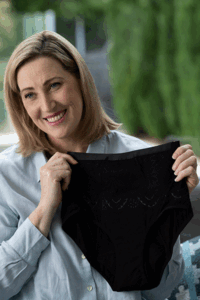World Continence Week is a time to open the floor and hear stories of those who have lived with the experience of incontinence and empower them to live confidently, seeking the help they need. This week is also a reminder of how many of us have experienced, or live with incontinence, removing the shameful stigma.
Incontinence isn’t a taboo topic. In fact, over five million Australians, aged over 15 years, experience bladder or bowel incontinence.
Olympic champion, women’s health expert, author, and Modibodi ambassador, Dr Jana Pittman, has spoken openly about her own experience with incontinence after six children, from her World Championship racing days to those broadcasted on national TV (SAS Australia).
Dr Jana sat down with Modibodi to discuss her experience with incontinence, and why she chooses the life- changing absorbent apparel brand.
How common is incontinence?
Urinary incontinence affects one in four women, but as we age it reaches around 75 per cent of women (over 65 years).
Why is more common in females than men?
It is fairly common in both men and women, but yes, research shows more women are prone to leakage than men due to life events like pregnancy, childbirth, hysterectomy, and menopause which can affect the female pelvic floor muscle structure.
What are the different types?
There are two main types of urine incontinence, stress incontinence and urge incontinence although many people have a combination of both which is called mixed incontinence.
Urge incontinence is the inability to prevent leakage due to the sudden urge to void without delay. This type of incontinence usually is caused by increased bladder pressure and tension (can’t hold urine at normal pressures). The bladder tends to contract too much, and this pressure initiates premature voiding. Stress incontinence is urine leakage occurring due to ‘bladder stress’, for example, in physical activities, such as coughing, laughing, sneezing, jumping or even walking.
What are the causes?
There are many causes for incontinence, and it’s not only women who have given birth. Pregnancy and childbirth stretch the pelvic floor, which can lead to muscle weakness and prolapse, but even menopause is a common cause as the vagina and urethra become dry and thin. Being overweight, smoking, constipation, certain medications, and urinary tract infections can also lead to incontinence. There are also conditions like multiple sclerosis and diabetes that are known to be related to increased rates of urinary leakage.
Is it curable? What are the treatments and management techniques?
Many of the causes of incontinence can be managed by either improving the muscles and internal pessaries or wearing leakproof underwear or pads. When you come to see a doctor, the first thing they will talk about is intake-output and whether there are certain drinks like caffeine, alcohol, and soft drinks which might be contributing to the incontinence (and are easily removed). Then you will be asked to keep a bladder diary to work out when it’s problematic and if it’s associated with drinking, a full bladder or stress on the pelvic floor. Most commonly, doctors start by sending you to a physiotherapist that specialises in pelvic floor rehabilitation, but there are online programs you can do at home to strengthen these muscles. Just like other muscles, they need to be trained and, in the meantime, invest in some good leak-proof underwear like Modibodi.
Depending on the type or cause of your incontinence, there are internal devices called intravaginal pessaries and medications (bladder relaxants) that can be considered, and even surgery, but it’s definitely best to exhaust the non-invasive options first.
What do you find is the biggest roadblock for women not getting treated for incontinence?
Embarrassment, especially with younger women who don’t realise they aren’t alone and that it is quite common. It is hard to admit you are wetting yourself, which is one of the reasons I decided to admit it on national TV during my SAS Australia show, as we need to be brave and seek help.
How can we help break down the stigma for incontinence?
We need to talk about it unashamedly! Get help yourself, see a women’s health physio or doctor. Then share your story! The more we normalise the issue, the more women will seek help. Use products like Modibodi to share the message and discuss what works for you with others!
Modibodi Ultra

Modibodi’s Sensual Hi-Waist Ultra Incontinence Brief is a comfortable and dignified solution to managing incontinence. A classic design with full coverage and reliable protection, the Sensual Hi-Waist Brief is our most absorbent style to date – holding up to 250mls.
Designed to manage incontinence discreetly, comfortably, and without leaks or odour, this style looks and feels like everyday underwear but with a built-in floating leak-proof lining that completely replaces disposable incontinence pads or underwear.
You can learn more about Modibodi’s Ultra range here.




